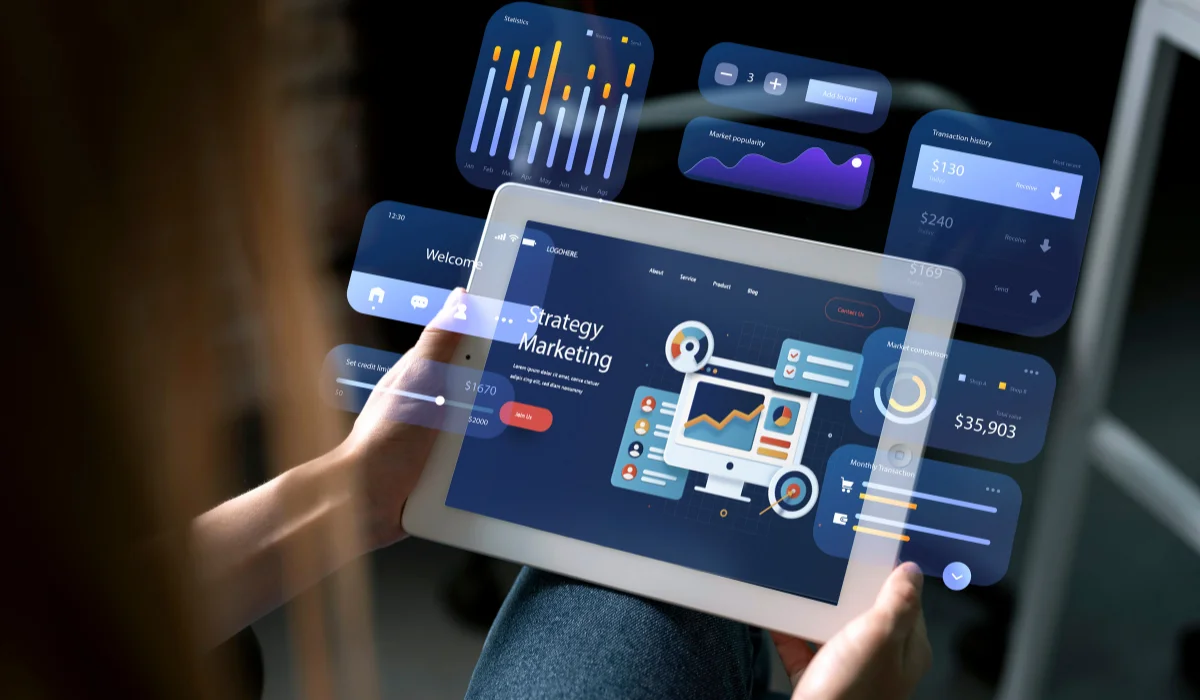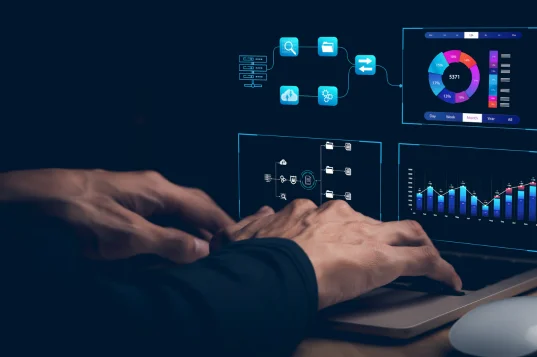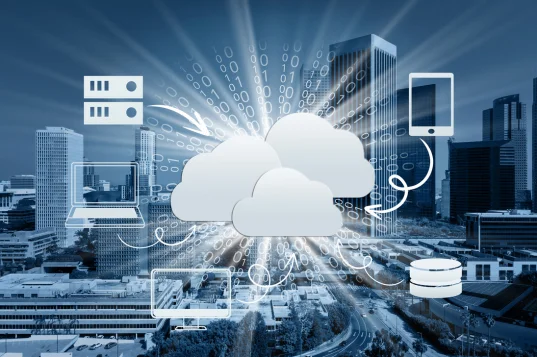At present, a data-driven society often brings light to two terms that often get mixed up: data science and visualization. Both play integral parts in how we interpret and utilize our information, yet many still misinterpret what each has to offer. Understanding their distinction can benefit businesses opting for data science consulting.
Data Science, or information extraction from data, encompasses everything from collecting to developing complex machine learning models. Its main aim is to make information useful and actionable.
Data Visualization, on the other hand, is the art and science of representing data visually in charts, graphs, or maps to simplify complex information and make it easier to interpret and act upon.
Why should you care? Understanding each field helps to leverage data more effectively—whether that means optimizing operations for business purposes or honing skills as an individual. Knowing about these fields gives a significant edge.
What is Data Science?
It is a multidisciplinary field focused on extracting insights and knowledge from data. It combines elements of statistics, computer science, and domain expertise. The primary goal is to turn raw data into meaningful information to drive decision-making and solve complex problems. Data Science applies to numerous industries, including healthcare, finance, marketing, and technology. Some of the key components of data science are:
1. Data Collection
Data Collection is the first step in the data science process. It involves gathering data from various sources, such as databases, sensors, social media, and surveys. The quality and relevance of the data collected are crucial.
Good data collection ensures that subsequent steps in the Data Science process are based on accurate and comprehensive information.
2. Data Cleaning and Preparation
Once data is collected, it needs to be cleaned and prepared. This step involves removing errors, handling missing values, and transforming data into a suitable format. Data Cleaning makes sure that the data is accurate and consistent.
Data Preparation may include normalizing data, encoding categorical variables, and then splitting data into training and testing sets. This step is essential for building reliable and accurate models.
3. Data Analysis
Data Analysis is the process of identifying patterns and relationships within the data. Various statistical techniques and algorithms are used in this step.
Exploratory data analysis (EDA) helps us understand the underlying structure of the data. Visualization tools are often used to make the analysis more intuitive. Data Analysis helps us form hypotheses and guide the direction of further analysis.
4. Machine Learning and Statistical Modeling
Machine Learning and Statistical Modeling are core components of Data Science. Machine Learning involves training algorithms to make predictions or classify data. It includes techniques like regression, classification, clustering, and neural networks.
Statistical Modeling uses mathematical models to represent data and identify relationships. Both approaches aim to predict outcomes and uncover hidden patterns. They enable data-driven decision-making and process automation.
5. Data Interpretation and Communication
Communicating and interpreting the results of data analysis is crucial. Data Interpretation involves making sense of the analysis results and drawing meaningful conclusions. Communication involves presenting these findings to stakeholders in an understandable way.
Visualization tools, such as charts and graphs make the data more accessible. Effective communication ensures that insights from Data Science can be acted upon. It bridges the gap between data scientists and decision-makers.
Common Tools and Technologies Used in Data Science
Data Scientists use various tools and technologies to carry out their work. Here are some of the most common ones:
- Programming Languages: R and Python are the most popular languages in Data Science. They offer extensive libraries for data manipulation, analysis, and machine learning.
- Data Manipulation Tools: Pandas and NumPy in Python are essential for data manipulation and analysis. They provide powerful data structures and functions to work with large datasets.
- Visualization Tools: Matplotlib, Seaborn, and Plotly are famous visualization tools in Python. They help in presenting data insights in an easily understandable format.
- Machine Learning Libraries: Scikit-learn, TensorFlow, and PyTorch are widely leveraged for developing and deploying machine learning models. They provide robust frameworks for training algorithms and handling complex computations.
- Big Data Technologies: Apache, Hadoop, and Spark process and analyze large datasets. They enable distributed computing and can handle vast amounts of data.
- Database Management Systems: SQL, NoSQL databases, and data warehousing solutions like Amazon Redshift and Google BigQuery are essential for storing and querying large datasets.
- Integrated Development Environments (IDEs): Jupyter Notebooks and PyCharm are popular among data scientists for writing and testing code. They provide interactive environments for developing and documenting workflows.
- Version Control Systems: Git and GitHub are crucial for managing code versions and collaborating with other data scientists. They help track changes and share code repositories.
What is Data Visualization?

The term data visualization involves presenting data in visual or graphic formats, like graphs, charts, maps, and infographics. The main purpose of data visualization is to make complicated data easier to comprehend and easily accessible. Through transforming information into visual format it becomes much easier to recognize patterns or trends and outliers. This assists in making quick and efficient decisions based on data.
Data Visualization is used across various industries. In business, it aids in presenting sales data, financial metrics, and performance indicators. In healthcare, it helps in tracking patient outcomes and disease outbreaks. In education, it visualizes student performance and educational trends. The scope of data visualization is vast, encompassing any field that relies on data interpretation.
Key principles of data visualization are:
Visual Encoding
Visual encoding is the method of representing data values through visual elements. This includes using shapes, colors, positions, and sizes to convey information. Each visual element corresponds to a specific data point or variable. For instance, in a bar chart, the length of each bar represents a data value. Effective visual encoding makes data easier to read and understand. It ensures that viewers can quickly grasp the information being presented.
Design Principles
Design Principles are guidelines that help create clear and effective visualizations. These principles ensure that visualizations are both informative and aesthetically pleasing.
Key design principles include:
- Simplicity: Try to avoid clutter and majorly focus on essential data. Simple designs are easier to understand.
- Consistency: Use uniform colors, fonts, and styles throughout the visualization. Consistency helps in maintaining a cohesive look.
- Accuracy: Represent data accurately without distorting the information. Misleading visuals can result in incorrect interpretations.
- Accessibility: Ensure visualizations are accessible to all users, including those with disabilities. Use colors and contrasts that are easy to differentiate.
Data visualizations can effectively communicate information and engage viewers by following these principles.
Interactive Visualization
Interactive visualization allows users to engage with data dynamically. Unlike static charts, interactive visualizations enable users to explore data by zooming, filtering, and hovering over elements. This interactivity helps users gain deeper insights and uncover hidden patterns. For example, an interactive dashboard can allow users to drill down into some specific data points or change the parameters of the displayed data. Interactive visualization enhances the user experience and provides a more comprehensive understanding of the data.
Common Tools and Technologies Used in Data Visualization
Data Visualization relies on various tools and technologies to create compelling visual representations of data. Some of the most common tools include:
1. Tableau
Tableau is a popular and extensively used tool for visualizing data. It offers various tools for the creation of interactive and shared dashboards. Tableau connects data sources and allows users to create sophisticated visualizations in a matter of minutes.
2. Power BI
Microsoft Power BI is a tool for business analytics that provides interactive visualizations and capabilities for business intelligence. It works well with Microsoft Power BI and other Microsoft software and it is a favorite by businesses for its extensive capabilities.
3. D3.JS
It is a JavaScript library that allows you to create interactive and dynamic data visualizations on the internet. It allows developers to connect data to an Object Model for Documents (DOM) and use transformations that are driven by data. D3.js is extremely customizable which makes it a preferred choice for web developers.
4. Google Data Studio
Google Data Studio is a completely free tool that transforms data into clear, easy-to-read dashboards and reports that are shareable. It works with many Google services as well as other data sources and makes it a powerful tool to visualize data.
5. QlikView
It is a platform for business intelligence that provides impressive information visualization capabilities and discover features. It lets users create Interactive dashboards as well as reports to help discover the hidden insights.
6. Infogram
It is an online tool to create infographics as well as visual representations of data. It also offers a variety of templates and customizable options that allow users to design professional-looking graphics.
7. Matplotlib and Seaborn
Matplotlib and Seaborn are Python libraries for creating static, animated, and interactive visualizations. They are popular among data scientists for their ease of use and versatility.
8. Excel
Although primarily a spreadsheet tool, Microsoft Excel offers robust data visualization features. It is mainly used for creating charts, graphs, and dashboards.
Data Visualization tools are crucial in transforming raw data into meaningful visual insights. By leveraging these tools, organizations can better understand their data, communicate findings effectively, and make informed decisions. As data grows in volume and complexity, the importance of Data Visualization in extracting value from data cannot be overstated.
Core Differences Between Data Science and Data Visualization
Understanding the core differences between Data Science and Data Visualization involves looking at their distinct purposes, required skills, and workflows. Each plays a unique role in handling and interpreting data.
#Purpose and Objectives
When discussing the purpose and objectives of data science and data visualization, it’s essential to recognize their different goals.
1. Analytical vs. Communicative
Data Science is fundamentally analytical. Its main goal is to dig into data in order to discover valuable insight. Data Scientists utilize statistical methods along with machine learning techniques to analyse complicated datasets. They attempt to identify patterns, predict trends for the future and offer actionable suggestions in light of their findings.
Data Visualization focuses on communicating. Its primary goal is to present information in a manner that’s easy to comprehend and understand. With visual elements such as graphs, maps, and charts, Data visualization transforms raw data into visual narratives. This helps people to understand the complex information quickly and make educated decisions based upon the visuals.
#Skill Sets and Expertise Required
The skill sets needed for Data Science and Data Visualization are distinct and specialized.
1. Data Science Skills
To leverage Data Science, professionals need a diverse set of skills:
- Statistical Analysis: Understanding and applying statistical methods to interpret and analyze data accurately.
- Programming: Expertise of programming languages like Python and R to manipulate and process data.
- Machine Learning: Knowledge of ML algorithms and models to make data-driven predictions and automate processes.
- Data Wrangling: Ability to clean and organize data from various sources, preparing it for analysis.
These skills enable Data Scientists to work with large datasets, build predictive models, and generate valuable insights from complex data.
2. Data Visualization Skills
On the other hand, Data Visualization requires a different set of skills:
- Design Principles: Understanding design concepts to create clear, engaging, and effective visual data representations.
- Tools Proficiency: Expertise in visualization tools like Tableau, Power BI, or D3.js to develop and present visual data.
- Storytelling: The ability to craft compelling stories through visuals that make data insights more accessible.
- User Experience: Knowledge of how users interact with visualizations, ensuring they are intuitive and user-friendly.
Data Visualization experts focus on making data comprehensible and visually appealing, helping audiences quickly grasp key insights and trends.
#Processes and Workflows
The processes and workflows for Data Science and Data Visualization also differ significantly.
1. Data Science Workflow
The Data Science workflow is comprehensive and iterative, typically involving:
- Data Collection: Gathering data from various sources to create a robust dataset.
- Data Cleaning: Removing inaccuracies and inconsistencies to ensure data quality.
- Exploratory Analysis: Examining the data to uncover patterns and insights.
- Model Building: Developing predictive models and algorithms based on the data.
- Evaluation: Assessing model performance and making necessary improvements.
This workflow emphasizes a deep dive into data to refine and enhance analytical models.
2. Data Visualization Workflow
The Data Visualization workflow, while still detailed, focuses more on presenting data effectively:
- Data Preparation: Ensuring the data is accurate and formatted for visualization.
- Choosing the Right Visualization: Selecting appropriate visual formats to represent the data best.
- Design and Creation: Designing and creating the visual representation with clarity and appeal.
- Review and Iteration: Testing the visualization for effectiveness and adjusting as needed.
- Presentation: Sharing the final visualization with the target audience and gathering feedback.
This workflow is centered on making data accessible and engaging, emphasizing clear and effective communication.
Data Science and Data Visualization serve different but complementary purposes. Data Science focuses on in-depth analysis and insight generation, requiring a technical skill set. Data Visualization focuses on presenting data clearly and engagingly, relying on design and communication skills. Understanding these differences helps in utilizing each field to its full potential.
Challenges of Data Science
Many challenges and limitations are encountered when working with data science and visualization. These issues may affect the accuracy and effectiveness of the data science and visualization work. Therefore, it is important to know the limitations before taking data science consulting.
Some of the most commonly encountered issues with data science are:
1. Data Quality Issues
One of the most difficult tasks for Data Science is ensuring data quality. Data is often sourced from many sources, which may have different levels of accuracy and dependability. Inconsistency in data can lead to flawed analysis. Data scientists spend a considerable quantity of time cleaning and making data. This process, also known as data wrangling, is vital; however, it can be time-consuming.
2. Scalability
Scalability is a different issue. As the amount of data increases, so does the complexity of analyzing and managing it. Traditional tools for processing data may have difficulty handling large amounts of data. Data scientists require advanced methods and tools to deal with large data, including distributed computing and cloud-based solutions. Making sure that systems scale efficiently is vital for handling huge quantities of data.
3. Ethical Considerations
Ethics are becoming more important in Data Science. With power comes great responsibility. Data scientists have access to sensitive data. They have to protect data confidentiality and safety. There are ethical issues to consider when they decide how to utilize data. Data misuse can cause significant damage, such as privacy violations and discrimination. It’s essential to follow the ethical guidelines and best methods.
Challenges of Data Visualization
1. Misinterpretation of Data
Data interpretation errors are a common issue in data visualization. Visuals are intended to simplify data. However, they could result in wrong conclusions. Visuals that are poorly designed can lead to misinformation. It is essential to utilize appropriate graphs and charts. Making sure that the visual conveys the information accurately is vital. Clear labeling and clear context are essential to prevent confusion.
2. Overloading Information
The problem of overloading information is another. A lot of data in one visualization could overwhelm the viewer. Simplicity is the key to effective Data Visualization. It is essential to concentrate on the most crucial data elements. Too many details could cause the visual to become confusing. The aim is to communicate information concisely and clearly. Making sure that there is no clutter and focusing on the message is crucial.
3. Accessibility and Inclusivity
Accessibility and inclusiveness are important aspects to consider regarding Data Visualization. Different people view information in a different manner, and cognitive and visual impairments could affect the way information is perceived. Designers need to ensure that their visualizations are accessible to all. This includes using color-blind-friendly palettes and providing alternative text descriptions. Inclusive design ensures that everyone has access to and comprehends the information.
Addressing Challenges and Limitations
Although data science and visualization issues are substantial, they can be solved using a thoughtful approach and the best methods.
1. Improving Data Quality
Improving the quality of data starts by ensuring that data is collected properly. It is vital to ensure that the data is correct and reliable right from the beginning. Regular audits and verifications aid in maintaining the quality of data. Automated tools can help prepare and clean data more effectively. Establishing solid data governance procedures is crucial to maintaining the integrity of the data.
2. Scalable Solutions
Scalability requires investment in the best technology. Cloud-based solutions offer the flexibility needed to handle vast amounts of data. Computer systems that use distributed computing, such as Hadoop and Spark, can handle large data faster. Implementing scalable architectures will ensure that the system can expand in line with the amount of data. Continuously reviewing and updating these systems is essential to keeping pace with the growth of data.
3. Ethical Guidelines
Ethics guidelines must be an integral part of Data Science techniques. Setting clear guidelines for privacy and data usage is vital. Regular training in ethical issues will help Data Scientists stay informed. Engaging with stakeholders and evaluating the social impact of data projects is essential. Respecting ethical standards helps build trust and ensure an ethical use of data.
4. Effective Data Visualization
The creation of effective data visualizations requires a focus on simplicity and clarity. The right kind of data visualization is crucial. The clarity of the labels, legends, and contexts can prevent confusion. Testing by users can provide feedback on the quality of the visual. Re-designing in response to feedback will ensure the visuals convey the intended message.
5. Inclusive Design
Inclusive design is crucial to ensure accessibility. Using bright colors and high-contrast fonts is a great way to assist visually impaired people. Offering alternative text to images ensures that screen readers can convey the required information. Thinking about cognition load and designing to be simple can aid those with cognitive impairments. Inclusion-based design methods ensure that everyone can access and comprehend the information.
The two fields of Data Science and Data Visualization face distinct issues and limitations. Quality of data, scalability, and ethical considerations are the primary issues in Data Science. Incorrect interpretation, overload of information, and accessibility issues are among the major problems in Data Visualization.
To tackle these issues, you need meticulous planning, the appropriate tools, and a commitment to ethical and inclusive methods. When confronting these issues head-on, professionals from both fields can improve the effectiveness and precision of their work, eventually leading to improved decision-making and insight.
The Key Takeaway
In conclusion, data collection is considered a way of locating valuable data, with data science and data visualization as essential tools. Data Science digs into complex data to discover significant patterns and forecast future trends. However, Data Visualization helps make these data-driven insights simple to comprehend by translating them into visual formats.
Data Science consulting firms have experts who are proficient in the analytical tools required to understand complex data and visualize them into insights that are understandable and engaging. Together, they transform raw data into valuable information, enabling businesses to make better choices and meet their objectives.







